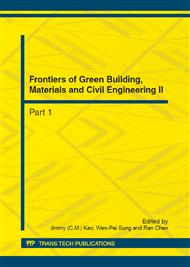p.107
p.111
p.115
p.121
p.125
p.129
p.133
p.137
p.142
Research on Evaluation Principle and Method for Green Building
Abstract:
The architecture of green building is a complex system engineering, it urgently need to build the green building evaluation tools as technical support for operation, and make the multi-level partners who participated in the construction process form the consensus. At present, some related evaluation system has been used for this, but they are not quite suitable for the related factors in building practice activity. Several key problems involved in the construction of green building evaluation tools must hold, such as the evaluation definition, the evaluation purpose, the structure frame, the evaluation scope, the operation index, etc. This paper point out the evaluation tool must have a clear goal for the behavior that would use it or use it as the ultimate objective. The evaluation tool should be concise, seize those important factors, and make its level in order, and finally build the green architecture evaluation system that is consistent with their requirement.
Info:
Periodical:
Pages:
125-128
Citation:
Online since:
August 2012
Authors:
Keywords:
Price:
Сopyright:
© 2012 Trans Tech Publications Ltd. All Rights Reserved
Share:
Citation:


